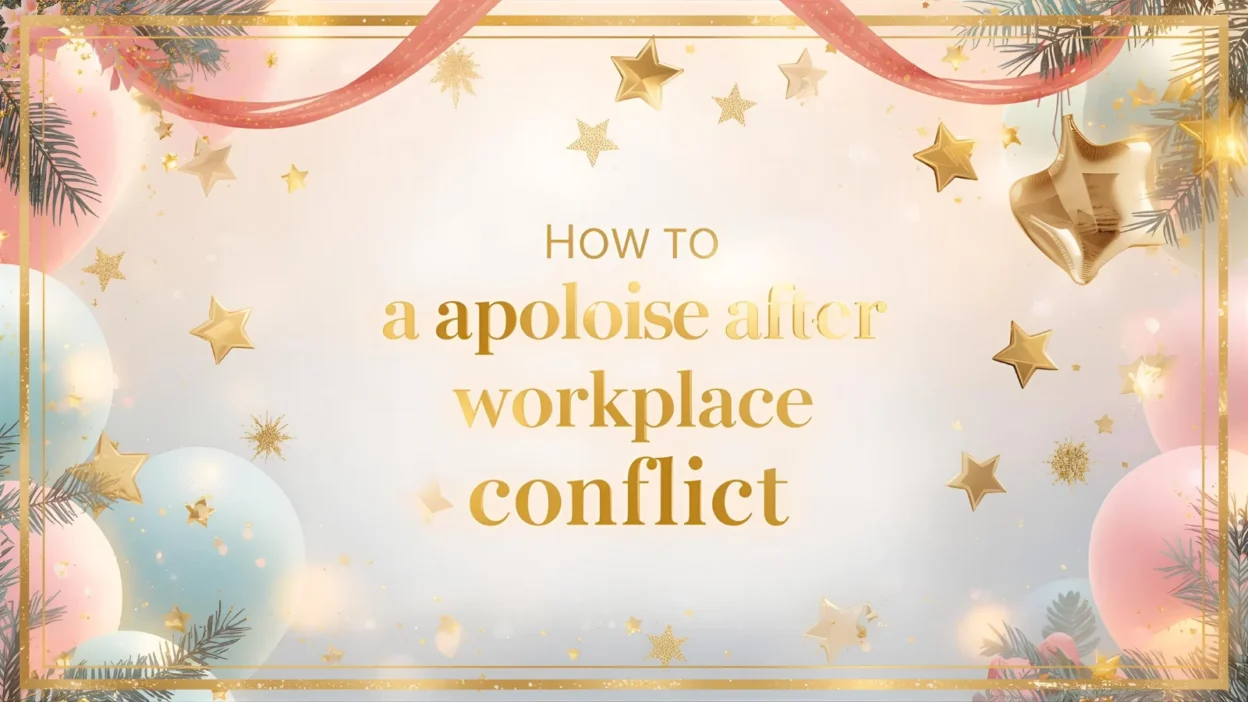Workplace conflicts are a natural part of professional life — disagreements, miscommunications, or even small frustrations can arise when people with different perspectives collaborate. What matters most is how we respond after the conflict. A sincere apology can rebuild trust, restore teamwork, and demonstrate emotional intelligence and professional maturity.
Learning how to apologize after a workplace conflict is an essential skill in any career. A well-crafted apology can turn tension into understanding and strengthen relationships. In this article, you’ll discover the steps to apologize effectively, the right words to use, and how to ensure your apology fosters lasting respect.
1. Understand the Importance of a Professional Apology
Apologizing is not about admitting defeat — it’s about taking responsibility.
When you acknowledge mistakes openly, you display integrity, humility, and respect for others.
A professional apology can:
- Repair damaged relationships
- Prevent future misunderstandings
- Encourage open communication
- Build a culture of trust
Remember, leadership begins with accountability, and every sincere apology reflects emotional strength, not weakness.
2. Reflect on the Situation Before You Speak
Before offering an apology, pause and reflect on what happened. Ask yourself:
- What caused the misunderstanding?
- What could I have done differently?
- How might my words or actions have affected others?
Reflection allows you to approach the apology with clarity rather than emotion. It shows that your apology is intentional, not impulsive.
3. Choose the Right Time and Setting
Timing and privacy are essential. Never apologize in the middle of a heated argument or in front of others.
Choose a neutral, calm environment — such as a private office chat, a coffee break, or a brief video call if you work remotely.
A private, calm discussion prevents embarrassment and ensures both parties feel heard.
4. Start with Empathy and Respect
Begin your apology by acknowledging the other person’s feelings. This helps lower defenses and shows that you understand their perspective.
Example:
“I realize my comment in the meeting may have come across as disrespectful. That wasn’t my intention, and I can see how it affected you.”
Empathy is the bridge to reconciliation. It validates emotions and sets a constructive tone.
5. Take Responsibility — Avoid Excuses
The most powerful apologies come from owning your part in the conflict. Avoid words like “if” or “but” — they weaken your sincerity.
✅ Say:
“I take full responsibility for how I handled that situation.”
❌ Avoid:
“I’m sorry if you felt that way, but I didn’t mean to.”
A true apology shows accountability without defensiveness.
6. Express Your Regret Clearly
After taking responsibility, express genuine regret. Use language that conveys sincerity, not formality.
Examples:
- “I truly regret that my words caused tension between us.”
- “I’m really sorry for raising my voice earlier — it wasn’t appropriate.”
- “I didn’t mean to make you feel undervalued, and I’m sorry that happened.”
Clarity and honesty make your apology believable.
7. Offer a Plan for Improvement
Actions speak louder than words. After apologizing, outline how you’ll prevent similar issues in the future.
“Moving forward, I’ll make sure to double-check my tone during meetings.”
“Next time, I’ll involve the whole team before finalizing a decision.”
This step shows growth, professionalism, and commitment to positive change.
8. Ask for Feedback and Listen
After your apology, give the other person a chance to speak.
“I’d like to hear how you felt about the situation — your perspective matters to me.”
Listening without interrupting shows humility and respect. Sometimes, people just need to feel heard to move forward.
9. Rebuild Trust Through Consistency
Apologies lose meaning if behavior doesn’t change. Rebuilding trust takes time and consistency.
- Follow through on promises
- Communicate openly
- Show appreciation for teamwork
Over time, consistent positive actions reinforce the sincerity of your apology.
10. Avoid Over-Apologizing
While apologizing is important, over-apologizing can make you seem unsure or insincere.
Once you’ve apologized and taken corrective action, allow space for healing.
Be confident in your growth and continue to contribute positively to the workplace.
11. Handle Group Conflicts Gracefully
If the conflict involved multiple people, acknowledge everyone’s perspectives respectfully.
“I’d like to apologize to the team for how I handled the situation during our last meeting. I appreciate your patience and commitment.”
This demonstrates leadership and fosters a collaborative environment.
12. Learn from Every Conflict
Every disagreement offers a lesson in communication, patience, or empathy.
Take notes on what triggered the conflict and how it was resolved. Over time, these lessons shape you into a stronger, more understanding professional.
13. Apologizing in Writing (When Needed)
If an in-person conversation isn’t possible, a professional email works well.
Keep it brief, respectful, and genuine:
“Hi [Name], I wanted to reach out and apologize for my tone during our last discussion. I value our working relationship and will make sure to communicate more thoughtfully moving forward.”
A well-written apology email can mend relationships even across distances.
14. When Not to Apologize Excessively
Sometimes, workplace tension arises from differences in opinion rather than mistakes.
If you’ve communicated respectfully, you don’t need to apologize for having a different view.
Stand by your ideas — but express them diplomatically.
15. Moving Forward with Positivity
After apologizing, focus on rebuilding rapport and positive energy.
Smile, engage, and work together on shared goals.
A repaired professional bond often becomes even stronger than before — built on mutual respect and understanding.
Conclusion
Knowing how to apologize after a workplace conflict is one of the most valuable communication skills a professional can master.
A sincere apology repairs bridges, restores collaboration, and promotes emotional intelligence in the workplace.
Remember:
✨ Reflect before speaking.
✨ Take responsibility without excuses.
✨ Show empathy, honesty, and action.
When you apologize with integrity and follow through with change, conflicts become opportunities for growth and connection — not division.
True professionals don’t avoid conflict; they resolve it with grace. 🌿
5 FAQs About Workplace Apologies
1. Should I apologize even if I wasn’t entirely wrong?
Yes. You can apologize for your role or tone without taking full blame. It shows maturity and empathy.
2. What if the other person doesn’t accept my apology?
Give them time. Continue showing respect and professionalism — trust rebuilds slowly.
3. Is it better to apologize in person or over email?
In person is ideal, but written apologies work well for remote or sensitive situations.
4. Can a manager apologize to a subordinate?
Absolutely. It strengthens respect and shows humility, setting a positive example.
5. How do I know if my apology worked?
When communication improves, tension fades, and cooperation returns — that’s success.



